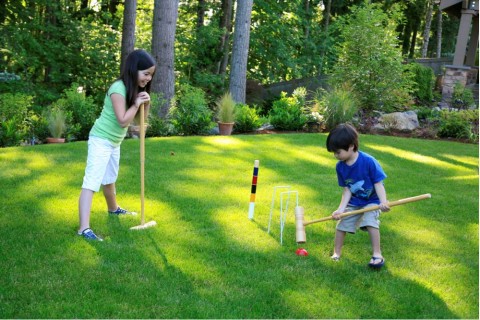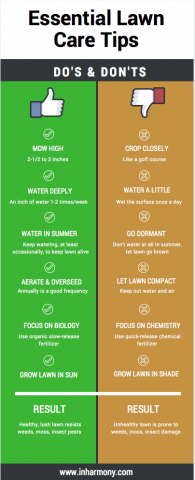
Use these lawn care practices to have a beautiful, healthy lawn that is the envy of your neighbors.
 Last week we posted an infographic on essential lawn care tips. It’s a quick look at practices to do, and not to do, to have a beautiful and healthy lawn.
Last week we posted an infographic on essential lawn care tips. It’s a quick look at practices to do, and not to do, to have a beautiful and healthy lawn.
This week we are providing more details to help you create a lawn that will be the envy of your neighbors.
Mow high for a healthy lawn
If you cut your lawn no shorter than 2-1/2 to 3 inches, it will develop a deep, healthy root system and excellent color. Higher grass blades shade out weeds and hold up better to potential damage.
In contrast, if you cut your lawn to only one inch tall, the root system will disintegrate and the lawn will become susceptible to disease, drought, heat, cold and stress.
Other mowing tips
- Mulch mow. When you leave clippings on the lawn, you add organic matter and nutrients. You can mulch mow with a regular mower and leave clippings on the surface to break down. Or use a mulching mower. It blows chopped clippings down to the soil, leaving a clean lawn.
- Mow frequently. If you mow every four to five days instead of every seven days, mowing time can be reduced up to 38 percent when you don’t bag your clippings.
- Maintain a sharp mower blade. This reduces disease potential and brown tipping.
- Never remove more than 1/3 of the leaf blade when mowing. This will prevent lawn shock and browning.
- Clean the blade regularly. Use alcohol wipes or a spray bottle with a diluted bleach solution.
Water deeply
You need to water long to enough to moisten the entire root zone. Frequent shallow watering encourages shallow roots. Your lawn will be more susceptible to drought.
Let the soil dry out between waterings. This prevents lawn disease and saves water.
Give your lawn about one inch of water once or twice a week. This includes rain. An oscillating sprinkler or impact sprinkler will do a good job. If you have automatic irrigation system, make sure it is adjusted and maintained properly so it waters evenly and doesn’t waste water.
How much is one inch of water a week? This short video will explain how to measure your sprinkler output.
Water in summer
Some people want to save water by letting the lawn go brown in summer. Ignoring your lawn all summer will make it thin and unhealthy, with bare spots where it has died out. This provides a great environment for invasion of weeds and moss in autumn when rains return.
You may be able to reduce watering in areas of the lawn that don’t see much traffic. But you still need to water your lawn occasionally to keep it alive. Your lawn will need an inch of water at least every few weeks.
If your lawn has a pest invasion, such as crane flies or chafer beetles, you need to continue regular watering, at least an inch a week, to keep it green and healthy.
Aerate and overseed for a healthy lawn
Soils naturally become compacted in the top 1 to 1-1/2 inches over time. Mechanical aeration removes small cores two to three inches deep into the soil.
Benefits of aeration
- Reduces soil compaction
- Improves oxygen content
- Stimulates root growth
- Improves fertilizer uptake
- Enhances water uptake
- Reduces water runoff and puddles
- Enhances tolerance for heat and drought stress
It is best to combine aeration with overseeding to fill in thin spots. This thickens the lawn, so weeds and moss have a difficult time getting established.
Spring and fall weather conditions are ideal for overseeding. Cooler air allows the seeds to grow without drying out. You will need to water initially. The seeds should show shoots in about 10 days if properly cared for.
In Harmony offers aeration and overseeding services in spring and fall. Call us if you would like to schedule a visit to your lawn.
Focus on biology
Organic, slow-release fertilizers feed your lawn slowly over time. They also add organic matter to the soil, increasing the biological activity. This helps keep your lawn healthy. Mulch mowing and top dressing with compost also add organic matter and nutrients to the soil.
In contrast, quick-release chemical fertilizers turn the lawn dark green, but the color won’t last. It’s like giving your lawn a sugar rush instead of good nutrition to build strong grass plants.
The most important time of year to fertilize is September. This is when grass plants are building roots for next year’s growing season. The next important time is late spring.
In Harmony’s lawn health care program focuses on adding organic matter to enhance the soil’s micro-organism population. In addition to applying organic fertilizer a few times a year, we may add lime or micro-nutrients. Call us if you would like to sign up for regular visits to help you grow a healthy lawn.
Grow lawn in sun
Make sure your lawn gets enough sunlight. Lawns need a minimum of four hours of direct sun each day.
Rather than attempting to grow a lawn in shade, consider planting shade-tolerant ground covers and other plants. Or thin trees that are shading the lawn so it gets more sunlight. We can help you with tree thinning and with lawn alternatives for shade.
Result
These lawn care steps will lead to a lush, healthy lawn that is resistant to weeds, moss and insect pests.
Contact us to find out how our natural lawn care services can help you grow a beautiful, healthy lawn.
SaveSave
